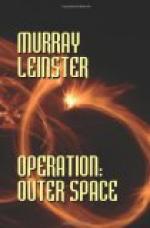He stopped Bell in his picture-taking and looked at the first of the prints. They were excellent. He went back to the vision-set to transmit them back to Luna. He sent them off. They would be forwarded to observatories on Earth and inspected. They literally could not be faked. There were thousands of stars on each print—with the Milky Way for background on some—and each of those thousands of stars would be identified, and each would have changed its relative position from that seen on earth, with relation to every other star. Astronomers could detect the spot from which the picture had been taken. But to fake a single print would have required years of computation and almost certainly there would have been slip-ups somewhere. These pictures were unassailable evidence that a human expedition had reached a point in space that had been beyond all human dreaming.
Then Cochrane had nothing to do. He was a supernumerary member of the crew. The pilot and Jones were in charge of the ship. Jamison would take care of the catering, when meal-time came. Probably Alicia Keith—no, Alicia Simms—would help. Nothing else needed attention. The rockets either worked or they didn’t. The air-apparatus needed no supervision. Cochrane found himself without a function.
He went restlessly back to the control-room. He found Babs looking helpless, and Jones staring blankly at a slip of paper in his hands, while the pilot was still at a blister-port, staring at the stars through one of those squat, thick telescopes used on Luna for the examination of the planets.
“How goes the research?” asked Cochrane.
“We’re stumped,” said Jones painfully. “I forgot something.”
“What?”
“Whenever I wanted anything,” said Jones, “I wrote it out and gave a memo to Babs. She attended to it.”
“My system, exactly,” admitted Cochrane.
“I wrote out a memo for her,” said Jones unhappily, “asking for star-charts and for her to get somebody to set up a system of astrogation for outside the solar system. Nobody’s ever bothered to do that before. Nobody’s ever reached even Mars! But I figured we’d need it.”
Cochrane waited. Jones showed him a creased bit of paper, closely written.
“I wrote out the memo and put it in my pocket,” said Jones, “and I forgot to give it to Babs. So we can’t astrogate. We don’t know how. We didn’t get either star-charts or instructions. We’re lost.”
Cochrane waited.
“Apparently Al was mistaken in the star he spotted as our sun,” added Jones. He referred to the pilot, whom Cochrane had not met before. “Anyhow we can’t find it again. We turned the ship to look at some more stars, and we can’t pick it out any more.”
Cochrane said:
“You’ll keep looking, of course.”
“For what?” asked Jones.
He waved his hand out the four equally-spaced plastic blister-ports. From where he stood, Cochrane could see thousands of thousands of stars out those four small openings. They were of every conceivable color and degree of brightness. The Milky Way was like a band of diamonds.




